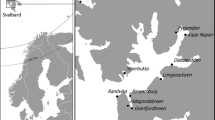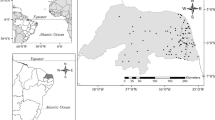Abstract
Data collected on zooplankton community composition over longer time periods (> 10 years) are rare. We examined among-lake spatial and temporal trends of zooplankton communities from a monitoring programme undertaken in the Waikato region, New Zealand. A total of 39 lakes were sampled over a period of 12 years, between 2007 and 2019, with varying degrees of temporal effort. We focussed particularly on eight lakes, considered here as ‘long-term lakes’, where samples were collected with greater regularity (including 5 with 12 years of data). Among lakes, suspended sediment concentrations and indicators of lake trophic state were inferred to be important in determining the zooplankton distributions; as this region is dominated by shallow lakes, the relative importance of suspended sediments was high. Among the long-term lakes, the greatest dissimilarities in zooplankton community composition among years were in Lake Waahi, where the Australian Boeckella symmetrica was first detected in 2012. That is, the greatest temporal changes to zooplankton composition during the study period were due to the invasion by non-indigenous species, rather than changes in trophic state or other environmental variables; non-native species commonly dominated the individual counts of species through much of 2014 and 2015, with most samples since 2016 being again dominated by native species. Following this lake, the largest and shallowest lakes in the dataset—Whangape and Waikare—exhibited the greatest variability in community composition among years.




Similar content being viewed by others
References
Abell JM, Özkundakci D, Hamilton DP, van Dam-Bates P, McDowell RW (2019) Quantifying the extent of anthropogenic eutrophication of lakes at a national scale in New Zealand. Environ Sci Technol 53:9439–9452
Baiao C, Boavida MJ (2005) Rotifers of Portuguese reservoirs in river Tejo catchment: relations with trophic state. Limnetica 24:103–114
Balvert SF, Duggan IC, Hogg ID (2009) Zooplankton seasonal dynamics in a recently filled mine pit lake: the effect of non-indigenous Daphnia establishment. Aquat Ecol 43:403–413
Banks CM, Duggan IC (2009) Lake construction has facilitated calanoid copepod invasions in New Zealand. Divers Distrib 15:80–87
Barbiero RP, Warren GJ (2011) Rotifer communities in the Laurentian Great Lakes, 1983–2006 and factors affecting their composition. J Great Lakes Res 37:528–540
Bayly IAE (1992) Guides to the identification of the microinvertebrates of the continental waters of the world 2: the non-marine Centropagidae (Copepoda: Calanoida) of the world. Academic Publishing bv., The Hague
Branford SN, Duggan IC (2017) Grass carp (Ctenopharyngodon idella) translocations, including hitchhiker introductions, alter zooplankton communities in receiving ponds. Mar Freshw Res 68:2216–2227
Burns CW, Mitchell SF (1980) Seasonal succession and vertical distribution of zooplankton in Lake Hayes and Lake Johnson. NZ J Mar Freshw Res 14:189–204
Burns N, Bryers G, Bowman E (2000) Protocol for monitoring trophic levels of New Zealand lakes and reservoirs. Lakes Consulting Client Report: 99/2 for the New Zealand Ministry for the Environment, Pauanui, New Zealand
Caughlan L, Oakley K (2001) Cost considerations for long-term ecological monitoring. Ecol Ind 1:123–134
Chapman MA, Green JD, Jolly VH (1985) Relationships between zooplankton abundance and trophic state of seven New Zealand lakes. Hydrobiologia 123:119–136
Chapman MA, Lewis MH, Winterbourn MJ (2011) Guide to the Freshwater Crustacea of New Zealand. New Zealand Freshwater Sciences Society, Christchurch
Couch KM, Burns CW, Gilbert JJ (1999) Contribution of rotifers to the diet and fitness of Boeckella (Copepoda: Calanoida). Freshw Biol 41:107–118
David BO, Jarvis M, Özkundakci D, Collier KJ, Hicks AS, Reid M (2019) To sea or not to sea? Multiple lines of evidence reveal the contribution of non-diadromous recruitment for supporting endemic fish populations within New Zealand’s longest river. Aquat Conserv Mar Freshw Ecosyst 29:1409–1423
Dexter E, Bollens SM, Rollwagen-Bollens G, Emerson J, Zimmerman J (2015) Persistent vs. ephemeral invasions: 8.5 years of zooplankton community dynamics in the Columbia River. Limnol Oceanogr 60:527–539
Duggan IC, Collier KJ (2018) Management of non-indigenous lacustrine animals. In: Hamilton D, Collier K, Quinn J, Howard Williams C (eds) Lake restoration handbook: a New Zealand perspective. Springer, New York, pp 299–331
Duggan IC, Green JD, Shiel RJ (2001) Distribution of rotifers in North Island, New Zealand, and their potential use as bioindicators of lake trophic state. Hydrobiologia 446(447):155–164
Duggan IC, Green JD, Shiel RJ (2002) Distribution of rotifer assemblages in North Island, New Zealand, lakes: relationships to environmental and historical factors. Freshw Biol 47:195–206
Duggan IC, Neale MW, Robinson KV, Verburg P, Watson NTN (2014) Skistodiaptomus pallidus (Copepoda: Diaptomidae) establishment in New Zealand natural lakes, and its effects on zooplankton community composition. Aquat Invasions 9:195–202
Duggan IC, Wood SA, West DW (2015) Brown trout (Salmo trutta) removal by rotenone alters zooplankton and phytoplankton community composition in a shallow mesotrophic reservoir. NZ J Mar Freshw Res 49:356–365
Dzialowski AR (2010) Experimental effect of consumer identity on the invasion success of a non-native cladoceran. Hydrobiologia 652:139–148
DOC and Fisheries NZ (2018) Standard for managing exotic hitchhiker copepods when transferring and releasing grass carp and silver carp. https://www.fisheries.govt.nz/dmsdocument/32257/direct. Accessed 20 Oct 2020
Forsyth DJ, McCallum ID (1980) Zooplankton of Lake Taupo. NZ J Mar Freshw Res 14:65–69
Gannon JE, Stemberger RS (1978) Zooplankton (especially crustaceans and rotifers) as indicators of water quality. Trans Am Microsc Soc 97:16–35
George DG, Harris GP (1985) The effect of climate on longterm changes in the crustacean zooplankton biomass of Lake Windermere, UK. Nature 316:536–539
Gilbert JJ (1988) Suppression of rotifer populations by Daphnia: a review of the evidence, the mechanisms and the effects on zooplankton community structure. Limnol Oceanogr 6:1286–1303
Gitzen RA, Millspaugh JJ (2012) Ecological monitoring: the heart of the matter. In: Gitzen RA, Millspaugh JJ, Cooper AB, Light DS (eds) Design and analysis of long-term ecological monitoring studies. Cambridge University Press, Cambridge, pp 3–22
Green JD, Shiel RJ (2001) Predation by the centropagid copepod, Boeckella major, structuring microinvertebrate communities in the absence of fish. Int Ver Theor Angew Limnol Verh 27:3691–3693
Green JD, Shiel RJ, Littler RA (1999) Boeckella major (Copepoda: Calanoida): a predator in Australian ephemeral pools. Archiv Hydrobiol 145:181–196
Gsell AS, Özkundakci D, Hébert M-P, Adrian R (2016) Quantifying change in pelagic plankton network stability and topology based on empirical long-term data. Ecol Ind 65:76–88
Hall DJ, Threlkeld ST, Burns CW, Crowley PH (1976) The size-efficiency hypothesis and the size structure of zooplankton communities. Annu Rev Ecol Evol Syst 7:177–203
Hart RC (1992) Experimental studies of food and suspended sediment effects on growth and reproduction of six planktonic cladocerans. J Plankton Res 14:1425–1448
Jeppesen E, Nõges P, Davidson TA, Haberman J, Nõges T, Blank K, Lauridsen TL, Søndergaard M, Sayer CD, Laugaste R, Johansson LS, Bjerring R, Amsinck SL (2011) Zooplankton as indicators in lakes: a scientific-based plea for including zooplankton in the ecological quality assessment of lakes according to the European Water Framework Directive (WFD). Hydrobiologia 676:279–297
Keller W, Yan ND, Somers KM, Heneberry JH (2002) Crustacean zooplankton communities in lakes recovering from acidification. Can J Fish Aquat Sci 59:726–735
Kirk KL (1991) Inorganic particles alter competition in grazing plankton: the role of selective feeding. Ecology 72:915–923
Kirk KL, Gilbert JJ (1990) Suspended clay and the population dynamics of planktonic rotifers and cladocerans. Ecology 71:1741–1755
Koste W (1978) Rotatoria, Die Rädertiere Mitteleuropas: Überordnung Monogononta. Gebruder Borntraeger, Berlin
Laboratories Hill (2011) Environmental catalogue, environmental division version 7.0. R. J. Hill Laboratories Ltd., New Zealand
Lindenmayer DB, Likens GE, Andersen A, Bowman D, Bull CM, Burns E, Dickman CR, Hoffmann AA, Keith DA, Liddell MJ, Lowe AJ, Metcalfe DJ, Phinn SR, Russell-Smith J, Thurgate N, Wardle GM (2012) Value of long-term ecological studies. Aust Ecol 37:745–757
Lindström ES (2000) Bacterioplankton community composition in five lakes differing in trophic status and humic content. Microb Ecol 40:104–113
Lovett GM, Burns DA, Driscoll CT, Jenkins JC, Mitchell MJ, Rustad L, Shanley JB, Likens GE, Haeuber R (2007) Who needs environmental monitoring? Front Ecol Environ 5:253–260
MacIsaac HJ, Gilbert JJ (1991) Discrimination between exploitative and interference competition between Cladocera and Keratella cochlearis. Ecology 72:924–937
Magurran AE, Baillie SR, Buckland ST, Dick JM, Elston DA, Scott EM, Smith RI, Somerfield PJ, Watt AD (2010) Long-term datasets in biodiversity research and monitoring: assessing change in ecological communities through time. Trends Ecol Evol 25:574–582
Mourelatos S, Lacroix G (1990) In situ filtering rates of Cladocera: effect of body length, temperature and food concentration. Limnol Oceanogr 35:1101–1111
Nandini S, Sarma SSS, Hurtado-Bocanegra MD (2002) Effect of four species of Cladocerans (Crustacea) on the population growth of Brachionus patulus (Rotifera). Acta Hydrochim Hydrobiol 30:101–107
O’Brien WJ, Luecke C (1988) The coexistence of a predaceous copepod and adaphniid: weeding and gardening in the Arctic. Verh Int Ver Limnol 23:2069–2074
Özkundakci D, Duggan IC, Hamilton DP (2011) Does sediment capping have post-application effects on zooplankton and phytoplankton? Hydrobiologia 661:55–64
Parkes SM, Duggan IC (2012) Are zooplankton invasions in constructed waters facilitated by simple communities? Divers Distrib 18:1199–1210
Pejler B (1983) Zooplanktic indicators of trophy and their food. Hydrobiologia 101:111–114
Reynolds CS (1998) What factors influence the species composition of phytoplankton in lakes of different trophic status? Hydrobiologia 370:11–26
Ricciardi A (2001) Facilitative interactions among aquatic invaders: is an ‘‘invasional meltdown’’ occurring in the Great Lakes? Can J Fish Aquat Sci 58:2513–2525
Shiel RJ (1995) A guide to identification of rotifers, cladocerans and copepods from Australian inland waters. Co-operative Research Centre for Freshwater Ecology, Albury
Spellerberg IF (1991) Monitoring ecological change. Cambridge University Press, Cambridge
Taylor CM, Duggan IC (2012) Can biotic resistance be utilized to reduce establishment rates of non-indigenous species in constructed waters? Biol Invasions 14:307–322
Ter Braak CJF, Smilauer P (1998) CANOCO for windows version 4.02. Centre for Biometry Wageningen, Wageningen, The Netherlands
Thomsen MS, Wernberg T, South PM, Schiel DR (2016) To include or not to include (the invader in community analyses)? That is the question. Biol Invasions 18:1515–1521
Vanni MJ (1986) Competition in zooplankton communities: suppression of small species by Daphnia pulex. Limnol Oceanogr 31:1039–1056
Vaughan H, Brydges T, Fenech A, Ashok L (2001) Monitoring long-term ecological changes through the Ecological Monitoring and Assessment Network: science-based and policy-relevant. Environ Monit Assess 67:3–28
Williamson M (1996) Biological invasions. Chapman and Hall, London, p 244
Yan ND, Somers KM, Girard RE, Paterson AM, Keller W, Ramcharan CW, Rusak JA, Ingram R, Morgan GE, Gunn JM (2008) Long-term trends in zooplankton of Dorset, Ontario, lakes: the probable interactive effects of changes in pH, total phosphorus, dissolved organic carbon, and predators. Can J Fish Aquat Sci 65:862–877
Acknowledgements
We thank all WRC staff involved in collection of samples through the duration of this monitoring and to Mark Hamer and Keri Neilson for their support towards the zooplankton monitoring programme in the Waikato region. Comments from three anonymous reviewers helped to improve the manuscript.
Author information
Authors and Affiliations
Corresponding author
Additional information
Publisher's Note
Springer Nature remains neutral with regard to jurisdictional claims in published maps and institutional affiliations.
Handling Editor: Télesphore Sime-Ngando.
Electronic supplementary material
Below is the link to the electronic supplementary material.
Rights and permissions
About this article
Cite this article
Duggan, I.C., Özkundakci, D. & David, B.O. Long-term zooplankton composition data reveal impacts of invasions on community composition in the Waikato lakes, New Zealand. Aquat Ecol 55, 1127–1142 (2021). https://doi.org/10.1007/s10452-020-09803-8
Received:
Accepted:
Published:
Issue Date:
DOI: https://doi.org/10.1007/s10452-020-09803-8




